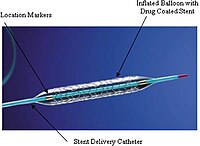
Photo from wikipedia
Coronary stents have revolutionized the treatment of coronary artery disease. Compared with balloon angioplasty, bare-metal stents effectively prevented abrupt vessel closure but were limited by in-stent restenosis due to smooth… Click to show full abstract
Coronary stents have revolutionized the treatment of coronary artery disease. Compared with balloon angioplasty, bare-metal stents effectively prevented abrupt vessel closure but were limited by in-stent restenosis due to smooth muscle cell proliferation and neointimal hyperplasia. The first-generation drug-eluting stent (DES), with its antiproliferative drug coating, offered substantial advantages over bare-metal stents as it mitigated the risk of in-stent restenosis. Nonetheless, they had several design limitations that increased the risk of late stent thrombosis. Significant advances in stent design, including thinner struts, enhanced polymers' formulation, and more potent antiproliferative agents, have led to the introduction of new-generation DES with a superior safety profile. Cardiologists have over 20 different DES types to choose from, each with its unique features and characteristics. This review highlights the evolution of stent design and summarizes the clinical data on the different stent types. We conclude by discussing the clinical implications of stent design in high-risk subsets of patients.
Journal Title: Cardiovascular research
Year Published: 2022
Link to full text (if available)
Share on Social Media: Sign Up to like & get
recommendations!